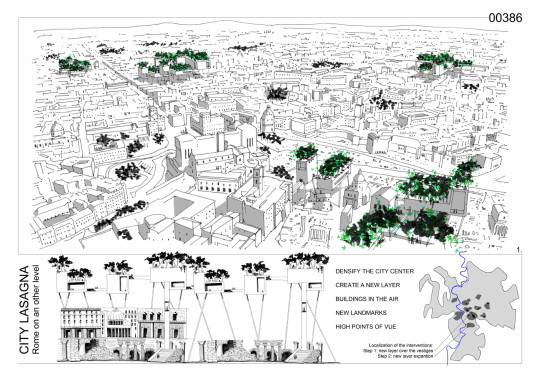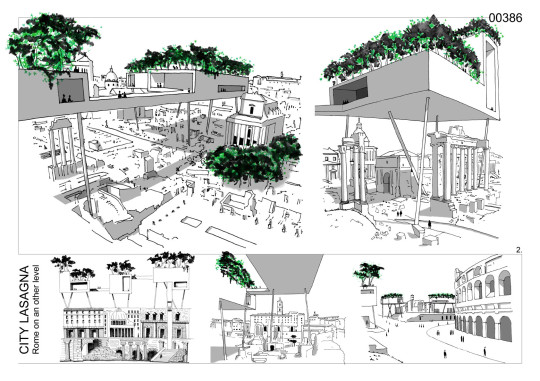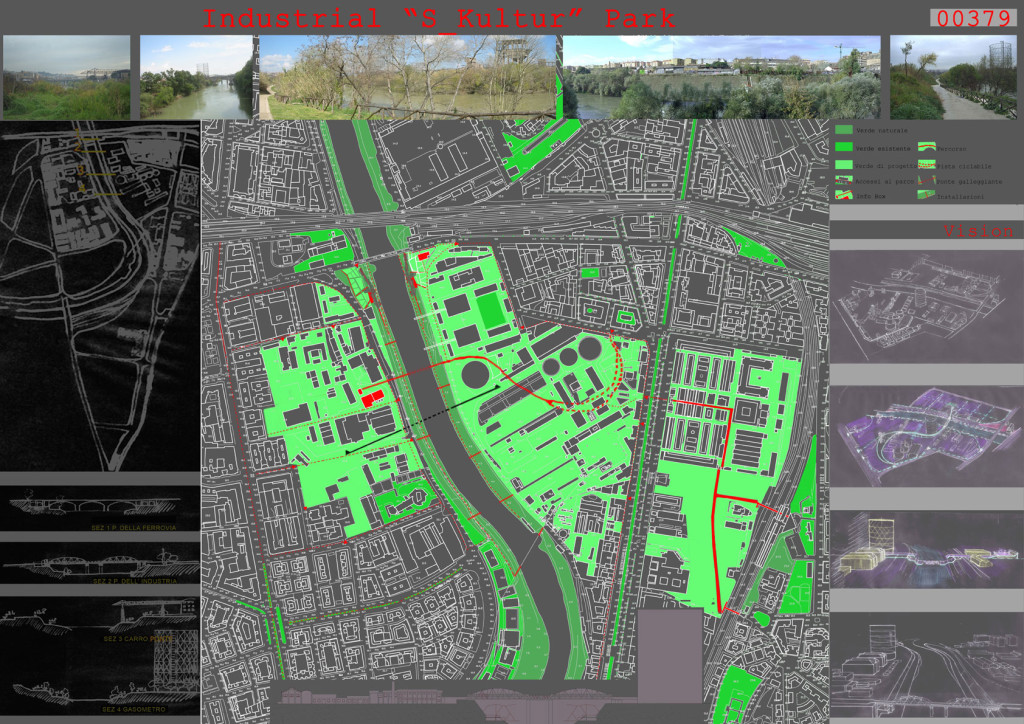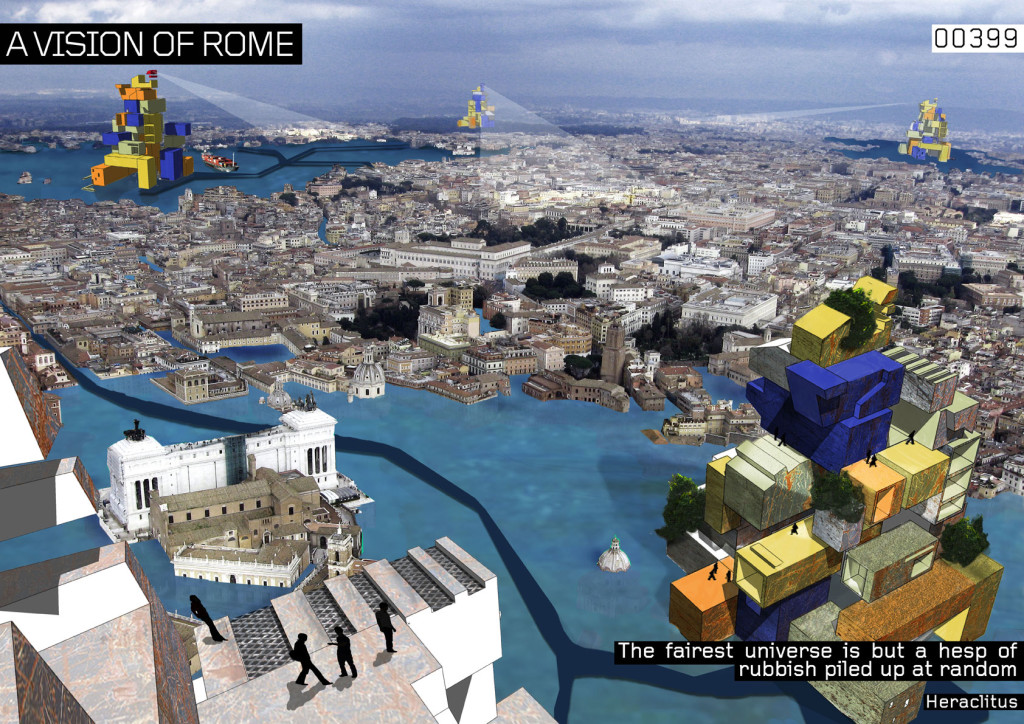Info:
Title: City Lasagna - Code: 00386Contest: Rome / 2010
By: B. DEVIGON / S. ROBINNE / F. GENOUVRIER
Views: 3660 Likes: 2
Votes:
JUERGEN MAYER H. 0 FRANCESCO LIPARI3 FELIPE ESCUDERO5 FRANCESCO GATTI 8 MICHAEL CATON 64.4
City Lasagna


CITY LASAGNA
Romeon an other level
The Twentieth century saw a rapid development of metropolitan cities as a result of readily available and affordable mass transit systems. The urban zones expanded without any limits, savagely taking over natural and agricultural areas.
With the increase in contamination and rarity of natural resources, the Twenty-first Century, with an emerging ecologic consciousness, is questioning more and more the uncontrollable growth of its numerous metropoles.
Instead of an unchecked expansion, cities, by concentrating activities and reducing transportation needs, can offer real solutions to our societies for the future. Quality of life standards, is now being measured by the population’s going to work by bike and going out at night by foot.
This development of dense urban areas, instead of the excessive spread of their periphery territories, can guide us toward a better planet with a decrease in the size of metropolitan cities and an increase in its natural resources.
One obstacle to the development ofRomelies under the feet of the inhabitants ofRometoday: the vestiges of the ancientRoman Empire. It’s out of the question to destroy the “basement” of the city, with its numerous ancient treasures in the city center along with their historical and patrimonial values. However, the preservation of the past makes it impossible to construct new structures. Every time a digging machine starts, the Holy Roman Empire which dominated all of Europe and the Mediterranean for many centuries resurfaces from below, like a resurrected phoenix, overpoweringRometoday and preventing the city from stepping in to the future.
Roland Barthes, in 1971, stated in his essay about cities thatRome”displays a permanent conflict between the functional necessities of modern life and the semantic responsibility conferred on it by its past”. He also added that “this conflict between meaning and function is what drives urban planners to desperation”. These issues he raised are still of actuality today.
For example, we can talk about the construction of the 3° subway line, which is being delayed again because of archeological sites found in the tunnels.
Frustrated by yet another obstacle, the director of theRomemetro states that,”we should privilege the living instead of the dead”. In other words,Romeshould accelerate the construction of the metro, despite the destruction of archeological sites.
On the other hand, as the commissioner of theRomeandNaplesmetro states, “archeology is an important resource for the economic and cultural development ofRome.” The tourist industry of theEternalCity, which brings enormous economic benefits for the city, is an essential display of the Italian heritage to the eyes of the entire world.
While people are complaining about the lack of contemporary urban or architectural interventions inRome, they are also amazed by the beauty of the old city and its historic buildings, with audio-guides to their ears.
The paradox of the situation is here: how to create spaces for anew cityto develop, while conserving the old “museum city”? How to flourish without complexes, while protecting and leaving access to the vestiges ofRome’s former glory?
To us, the organization ofRomein historical “stratas”, or “layers”, is favorable to a coherent reflection on the past, the present, and the future ofRome. In fact, through out its history, Rome has constructed and reconstructed once and again on itself, turning the city into a sort of “lasagna”, where each layer contributes to the richness of the whole dish.
Enchanted by the rediscovery of its glorious past, Renaissance and Baroque Rome literally placed structures right on top the the ruins of the Ancient Roman Empire to create a new city. The rubbles of theRoman Empirebecame foundations for new buildings and new life. This is a perfect metaphore of how a society can draw on resources of its past to build a future.
Applied to archeology, new technologies and methods with global sharing of information and knowledge can in many ways launch us into a new era of rediscovery and re-appropriation of the buried civilization below. The Romans today can continue in their process of stratified development of their city.
We propose, in a first stage, to densify the center of the city, by constructing over the vast areas of archeological vestiges, creating new development areas.
However, it is not necessary to place the new buildings right on top of the old stones, as the Romans in the past have done. Today’s and tomorrow’s materials and methods for construction and calculation can optimize tenfold the effectiveness of structures in buildings, allowing for lighter and strong supports.
In the near to long term future, we can also imagine to expand this system to other zones in the city. Each surface created in the city center is more space gained in the periphery or in nature. This stratification of the the city will allow a more livable and pleasant experience in the center, and more natural resources outside of the city to be reserved.
These “buildings in the air,” with their long legs extending beyond but not interfering with the ruins below, can become landmarks which are visible from the hills, and at the same time high points of vue over the city.
To build on top of the city’s past heritage means to protect it without altering or disturbing its beauty, allowing tourists’ circulation in the heart of the anticRome.
Romans today must reclaim the city of their ancestors, and draw on their roots to push themselves with confidence to the future.






